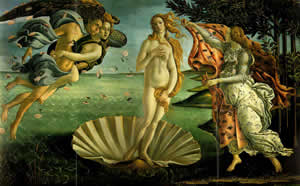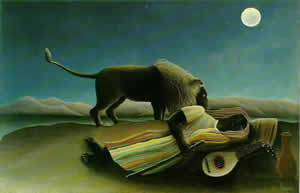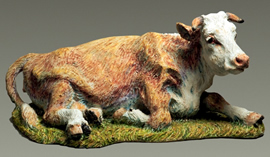|
|
 
Unit
2 - Theatre History
Module
3: Relating the Arts
Lesson
2 - Understanding the Arts
Introduction:
In every period in history, the arts are woven together to
create a complex tapestry that reflects the society of the time.
The values and key ideas of the time period form the key threads
in the tapestry, and in the context of political and social events,
the tapestry becomes a visual timeline. This lesson focuses on
a holistic approach to studying the arts, and helps students create
a mental tapestry by generating a physical time line.
Objectives:
- to understand that theatre is a synthesis of the arts
- to understand that theatre reflects the society that creates
it
- to understand the universality of certain themes, characters
and situations
Resources:
"Ideas and Inspiration" Contemporary Canadian Art CD-ROM
and slide kit (sent to every Saskatchewan high school by Sask
Education); art history reproductions; on-line research material
or library materials.
CELs:
C, CCT, TL, IL
Components:
Cultural/Historical, Critical/Responsive
Activity:
 |
Poster
"Historical
Timeline in Context" |
In order to fully appreciate a work of art, it is helpful to have
some knowledge of the time period in which it was created. We
can relate more meaningfully to a play if we have some understanding
of the events, customs, social structures and great works of art
particular to that time. It puts the play into context.
Below
is the beginning of a timeline in context. A work of art has been
selected, the date of the artist's life identified, and some important
works of art and historical events of the period are recorded.
Students
are to select another work of art, and create a poster which puts
the work into historical context. Follow the examples below for
categories. Once the class has completed their posters, hang them
in chronological order - or create a gallery space.
(AlternaTime
a web site devoted to alternative timelines, features politics,
arts, culture, etc)
Sample
work:
|
Sandro
Botticelli
(Italy)
date:
1444 - 1510
Other
Artists: Michelangelo,
da Vinci,
Raphael,
Donatello, Titian, El Greco; oil paintings more realistic
than ever before, use of perspective.
Theatre:
Everyman (morality play); 16th century - Shakespeare,
Marlowe, Jonson
Authors:
started writing in national languages such as French and
Italian (rather than Latin); emphasized individual personality;
Don Quixote - Miguel de Cervantes, Machiavelli, Castiglione.
Architecture:
centered
on people and their needs; attention now paid to homes,
palaces and public buildings - not just churches.
History:
spread of Renaissance ideas and attitudes; an age of adventure
and invention; focus is on the individual; inventions -
printing press; Columbus sails to America; 1543 Copernicus
proves the earth revolves around the sun; Protestant reformation
begins.
|

"Birth
of Venus"
Egg
Tempera on Canvas
1485
Collection
of Uffizi Gallery, Florence, Italy
|

"Sleeping
Gypsy"
Oil
on Canvas
1897
Collection
of the Museum of Modern Art, New York
|
Henri
Rousseau
(France)
date:
1844 -1910
Other
Artists: van Gogh, Seurat, Picasso, Monet, Cassatt,
Klimt, Munch, Renoir, Lautrec.
Theatre:
realism; 1st play with practical furniture (1848); greasepaint
invented; musical comedies; 1st electric lights in a theatre;
A Doll's House - Ibsen; Importance of being
Earnest - Wilde; Strindberg, Chekov, Shaw.
Authors:
Charles Dickens, Victor Hugo, Rudyard Kipling, Edgar Allan
Poe, Charles Baudelaire, Maupassant, Emile Zola.
Composers:
Saint - Saens, Franz Liszt, Wagner, Bruckner, Brahms,
Mahler, Johann Strauss, Puccini, Verdi, Rimsky-Korsakov,
Tchaikovsky, Gillbert & Sullivan.
History:
inventions - camera, telephone, early silent movie The
Great Train Robbery, automobiles, high rise buildings,
machine guns.
|
Joe
Fafard
born 1942
(Canadian)
Influences:
growing
up on a farm in Saskatchewan; refers to other artists
in art history; often chooses people he likes as subject
matter but is best known for his cow sculptures; Monet's
Cow refers to the work of French Impressionist Claude
Monet.
Theatre:
National
and Regional theatres perform new Canadian work; touring
companies; Robert LePage, Michel Tremblay; "mega"
Broadway shows such as Cats reignites public interest
in theatre.
Pop
Culture : Stephen
King, Michael Jackson's Thriller, disco's,
music video's, rap music reaches mainstream, Gandhi
sweeps major Academy awards, home computers starting
to hit the market.
History:
Canadian
Charter of Rights and Freedoms adopted, end of Trudeau
era, beginning of Reagan/Thatcher era, Soviet invasion
of Afghanistan, first artificial heart transplant.
|

"Monet's
Cow "
Clay,
acrylic
1982
26.2 x 60 x 33.2 cm
Collection
of Saskatchewan Arts Board
(For
more information about Joe Fafard and his work look at
the Sask Ed CD-ROM Ideas and Inspiration, a copy
was sent to every Saskatchewan high school school.)
|
Bonus Activity: Opera
Anyone?
Research
into a particular opera to see how it is designed and created.
Instructional
Strategies: research
project, model building
Evaluation:
A teacher created mark sheet for the poster should include a
mark of 5-10 for each content category, and should also include
marks for use of class time and visual appeal. Bonus work marks
must be discussed by the teacher and student before students
embark on bonus projects.
Alternative
On-line Activity:
scan the poster or complete the poster using a drawing program.
Submit the poster electronically to the site for the class and
create an on-line gallery.
Next
Lesson / Student Lesson
/ Previous Lesson
|
|











